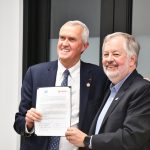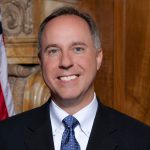State Labor Secretary Touts Wins in 2023
Record year for apprenticeships and much improved unemployment insurance system.

Wisconsin Department of Workforce Development’s secretary designee, Amy Pechacek, right, with Gov. Tony Evers at a DWD event held at the Plumbers Local 75 training center in Madison with WRTP/Big Step on Nov. 14, 2023, for an announcement about the growth of apprenticeship programs in Wisconsin. (Photo courtesy of DWD)
The year just ended set new workforce-related records for Wisconsin: a record high for jobs and a record low for unemployment.
Those 2023 milestones — 2.4% unemployment in April and May and more than 3 million jobs in November — have been widely reported. But Amy Pechacek, secretary-designee at the Wisconsin Department of Workforce Development (DWD) says some other records have gone largely unnoticed.
Wisconsin has enrolled 16,000 apprentices, who learn trades and skills on the job while earning a paycheck. Another 8,000 youth apprentices have also been enrolled. Both are record numbers, Pechacek said in a turn-of-the-year interview with the Wisconsin Examiner.
“And we have done that in partnership with a record number of employer sponsors, in a record number of career pathways,” Pechacek said. “We’ve really expanded that program into other, historically non-conventional pathways such as health care, IT [information technology], finance.”
In health care, DWD worked with the UW Health system of hospitals and clinics to establish a first-ever nursing apprenticeship program in the state. A registered apprenticeship includes payment for the hours spent in the classroom as well as on the job and covers costs related to schooling such as books and materials.
While the Legislature declined to fund Gov. Tony Evers’ budget requests for funding that would help develop a series of health care apprenticeship programs, UW Health is covering the cost of its pilot apprenticeship program, which was established prior to the budget.
With a shortage of nurses and other health care workers already putting pressure on providers as well as the existing workers in those fields, apprenticeships offer another avenue to help expand the workforce, said Pechacek.
“There are plenty of folks that are in lower skilled and lower-paying health care positions, such as reception work or lab work, who potentially may want to be a nurse, whether it be an LPN or an RN, but don’t have the money to afford to go to college or don’t have the time to leave the workforce to go to school to get the skills that they want,” she said.
Fixing the unemployment insurance system
Pechacek stepped into the DWD post midway through Gov. Tony Evers’ first term, assigned initially to direct the department as it struggled to overcome a backlog of more than 100,000 unemployment insurance (UI) claims in the COVID-19 pandemic. Evers fired his first DWD secretary, Caleb Frostman over the issue.
Republican lawmakers claimed the department hadn’t responded vigorously enough to the problem, but the Evers administration and Democratic legislators argued that long-standing problems in the UI system overwhelmed the agency in the face of a loss of more than 400,000 jobs and an unemployment rate that soared to 14%.
One factor in the delays, Democrats charged, was the number of UI restrictions enacted during former Gov. Scott Walker’s two terms, making the application process more cumbersome. Another was the 50-year-old computer system used to manage UI claims, which had been targeted years earlier for an upgrade that never took place.
The Legislature authorized the computer upgrade, but without funding it, in 2021. The Evers administration subsequently directed $80 million from the federal American Rescue Plan Act (ARPA) for the job, along with additional federal grants for specific elements of the project.
Pechacek said the upgrade is halfway through its four-year timeline and goes beyond technology fixes. DWD has revised its online portal for applicants to file claims. “There’s better functionality with efficiencies such as messaging and document upload,” she said.
Artificial intelligence-powered bots to provide virtual assistance for applicants are also being added. The department is reporting that 88% of UI applications that are approved are being paid within three days.
The goal, she said, is for Wisconsin to “never find itself in that situation that it found itself in in 2020.”
Addressing the workforce gap
Much of the department’s work is carrying out longstanding programs — assisting employers with new apprenticeship programs, advising them on local and regional labor market trends, or operating job centers around the state where people seeking work look for employment listings or get some career counseling.
At the same time there have been newer programs. Starting in 2021, the Evers administration through DWD and the Wisconsin Economic Development Corp. launched a series of ARPA-funded workforce-related projects — grants totaling $160 million to local and regional groups around the state.
Those projects are supposed to bring together groups of businesses and nonprofits in a region to focus on job training and placement supplemented with additional initiatives to address what local communities might identify as barriers keeping people from joining the workforce — transportation, housing or child care gaps. Pechacek said more than 33,000 Wisconsin residents have taken part in one of those workforce solutions projects.
One challenge that looms for the workforce is artificial intelligence. It’s the subject of a task force that Evers established and Pechacek chairs, with plans to produce recommendations for policy later in 2024.
AI, she said, is part of “the fourth industrial revolution” underway. She believes the state needs to be able to respond to that development in ways that help business and prepare the next generation of workers with “the skills they need early on to interact with this technology.” At the same time, she added, it will be important to “have policies that bring everyone along in a very accessible and equitable way.”
Demographics and the workforce shortage
Wisconsin’s aging population — without as many younger adults to replace those who retire — remains the leading challenge for the department. Pechacek said that has made efforts such as expanding apprenticeship and providing other ways to enter the workforce even more important.
“The state of Wisconsin over the past 10 years has had a net-zero to negative in-migration,” Pechacek said. She considers the key to keeping the next generation of Wisconsinites in the state “is to connect them early, like through apprenticeship with a local employer, with a local in-demand skill and with a local economy so they’re less likely to move across the country and start all over, because they are invested and an employer has invested in them.”
Those trends are also a reason, Pechacek said, that Wisconsin should take up proposals to provide paid family medical leave. The Legislature’s Republican majority deleted Evers’ proposal for that program from the 2023-25 state budget and again rejected it when the governor included it in a special session bill to address workforce issues. The need remains, Pachecek said.
An important priority is “making sure we continue to invest in supporting our workforce,” she added. States including California, Minnesota, Illinois and Michigan are among more than a dozen that have enacted some form of paid family leave.
Three of those states border Wisconsin. “Businesses on those borders are competing with those states directly for workers,” Pechacek said. “Policies that really support families and strong communities even support employers, because employers are better able to recruit and retain workers when they have some of these policies and benefits in place.”
The same is true of outside funding to support child care providers. Child care experts have called for ongoing subsidies for providers so that providers can afford to pay child care workers more in recognition of the skill the work requires without raising the fees parents pay to unaffordable levels.
The Legislature also rejected efforts that Evers made to provide continuing state funding for child care aid, something the federal government started to offer during the pandemic. Evers subsequently allocated some of the state’s remaining pandemic relief money to cover the cost into 2025.
“We know that child care is the workforce behind the workforce,” Pechacek said, “and if our working families don’t have access to affordable child care, they’re not going to be able to work. Those types of things are going to continue to strain our businesses, and then overall, the health of our economy, if we aren’t able to really uplift working families.”
State labor secretary reviews efforts to expand the workforce in Wisconsin was originally published by the Wisconsin Examiner.






















Gov Evers is doing great job with Workforce Development. Nursing Apprenticeships will fiil vacancies.
The Republican Legislators refused to fund it. They’re holding onto “surplus funds” for a big tax giveaway.